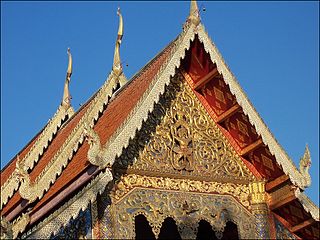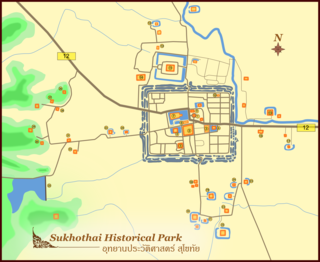
Sukhothai Historical Park covers the ruins of Sukhothai, literally 'dawn of happiness', capital of the Sukhothai Kingdom in the 13th and 14th centuries, in north central Thailand. It is near the city of Sukhothai, capital of Sukhothai Province.

Narathiwat is one of the southern provinces (changwat) of Thailand. Neighboring provinces are Yala and Pattani. To the south it borders the Malaysian state of Kelantan. The southern railway line ends in this province, which is one of the nation's four provinces that border Malaysia. The province features a range of cultures as well as natural resources, and is relatively fertile. Narathiwat is about 1,140 kilometers south of Bangkok and has an area of 4,475 square kilometers. Seventy-five percent of the area is jungle and mountains and has a tropical climate.
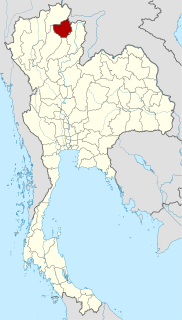
Phayao is one of the northern provinces (changwat) of Thailand. Neighboring provinces are Nan, Phrae, Lampang, and Chiang Rai. In the northeast it borders Xaignabouli of Laos.

Suphan Buri is one of the central provinces (changwat) of Thailand. Neighbouring provinces are Uthai Thani, Chai Nat, Sing Buri, Ang Thong, Phra Nakhon Si Ayutthaya, Nakhon Pathom and Kanchanaburi.

Traditional Thai art is primarily composed of Buddhist art and scenes from the Indian epics. Traditional Thai sculpture almost exclusively depicts images of the Buddha, being very similar with the other styles from Southeast Asia, such as Khmer. Traditional Thai paintings usually consist of book illustrations, and painted ornamentation of buildings such as palaces and temples. Thai art was influenced by indigenous civilizations of the Mon and Khmer. By the Sukothai and Ayutthaya period, thai had developed into its own unique style and was later further influenced by the other Asian styles, mostly by Sri Lankan and Chinese. Thai sculpture and painting, and the royal courts provided patronage, erecting temples and other religious shrines as acts of merit or to commemorate important events.

Wat Pho, also spelled Wat Po, is a Buddhist temple complex in the Phra Nakhon District, Bangkok, Thailand. It is located on Rattanakosin Island, directly south of the Grand Palace. Known also as the Temple of the Reclining Buddha, its official name is Wat Phra Chetuphon Wimon Mangkhalaram Rajwaramahawihan. The more commonly known name, Wat Pho, is a contraction of its older name Wat Photaram.

A thangka, variously spelt as thangka, tangka, thanka, or tanka, is a Tibetan Buddhist painting on cotton, silk appliqué, usually depicting a Buddhist deity, scene, or mandala. Thangkas are traditionally kept unframed and rolled up when not on display, mounted on a textile backing somewhat in the style of Chinese scroll paintings, with a further silk cover on the front. So treated, thangkas can last a long time, but because of their delicate nature, they have to be kept in dry places where moisture will not affect the quality of the silk. Most thangkas are relatively small, comparable in size to a Western half-length portrait, but some are extremely large, several metres in each dimension; these were designed to be displayed, typically for very brief periods on a monastery wall, as part of religious festivals. Most thangkas were intended for personal meditation or instruction of monastic students. They often have elaborate compositions including many very small figures. A central deity is often surrounded by other identified figures in a symmetrical composition. Narrative scenes are less common, but do appear.

The history of Asian art or Eastern art, includes a vast range of influences from various cultures and religions. Developments in Asian art historically parallel those in Western art, in general a few centuries earlier. Chinese art, Indian art, Korean art, Japanese art, each had significant influence on Western art, and, vice versa. Near Eastern art also had a significant influence on Western art. Excluding prehistoric art, the art of Mesopotamia represents the oldest forms of Asian art.
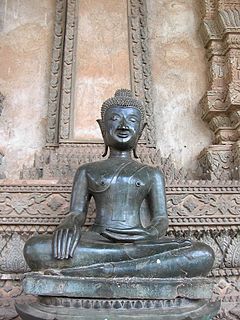
The iconography of Gautama Buddha in Laos and Thailand recall specific episodes during his travels and teachings that are familiar to the Buddhists according to an iconography with specific rules. The Buddha is always represented with certain physical attributes, and in specified dress and specified poses. Each pose, and particularly the position and gestures of the Buddha's hands, has a defined meaning which is familiar to Buddhists. In other Buddhist countries, different but related iconography is used, for example the mudras in Indian art. Certain ones of these are considered particularly auspicious for those born on particular days of the week.

Nan is a town in northern Thailand. It is 688 kilometres (428 mi) north of Bangkok. It is in the centre of Nan Province which bears its name, and of which it is the former administrative capital. It covers tambon Nai Wiang and parts of tambon Pha Sing of Mueang Nan District, an area of 7.60 square kilometres (2.93 sq mi) divided into 30 chumchon. In 2010 it had a population of 21,333 spread along the Nan River's right bank. Nan is a small city, primarily devoted to commercial, administrative, educational, and hospital activities. The old heart of the city, where Wat Phumin, the national museum and other tourist attractions are found, is being restored.

Buddhist art is the artistic practices that are influenced by Buddhism. It includes art media which depict Buddhas, bodhisattvas, and other entities; notable Buddhist figures, both historical and mythical; narrative scenes from the lives of all of these; mandalas and other graphic aids to practice; as well as physical objects associated with Buddhist practice, such as vajras, bells, stupas and Buddhist temple architecture. Buddhist art originated on the Indian subcontinent following the historical life of Siddhartha Gautama, 6th to 5th century BCE, and thereafter evolved by contact with other cultures as it spread throughout Asia and the world.

The lands situated in the present-day Phitsanulok Province of Thailand have been inhabited since the stone age, although the neolithic inhabitants of the region are not likely to have been the ancestors of the modern Thai people who reside there today. The earliest historical records relating to what is now Phitsanulok Province indicates that at a time prior to or during the 11th century, the present-day city of Phitsanulok was but a small strategic Khmer outpost known as Song Khwae. During the next century, in 1188, Nakhon Thai, located near the center of the present Phitsanulok Province, was established as the capital city of the Singhanavati Kingdom, an early city-state of Thailand. Later, during Thailand's Sukhothai Period, the city of Phitsanulok emerged as a major city in the east of the Sukhothai Kingdom, and the great temples of Wat Chula Manee, Wat Aranyik and Wat Chedi Yod Thong were constructed. In 1357, the renowned Wat Phra Sri Rattana Mahathat was erected, and the Ayutthaya Period witnessed the construction of several of the province's other chief temples. Phitsanulok served for 25 years as the capital city of the Ayutthaya Kingdom. In 1555, King Naresuan the Great was born in the city of Phitsanulok. Naresuan played a significant role in the history of Thailand, as he expanded the kingdom to its greatest territorial extent, by conquering sizable portions of modern-day Burma and Cambodia. In recent times, Phitsanulok Province has become an important agricultural center, part of the Bread Basket of Thailand, providing rice and other crops to consumers in Thailand and throughout the world. Extensive agricultural development over the last hundred years or so has spawned a modern infrastructure in the urban areas of the province, bringing with it an array of modern roads, universities, hospitals and other conveniences. Over the years, the Nan River and its tributaries have played a substantial role in the history and development of the region by providing a route for transportation, fertile soil for agriculture, and water for irrigation. The river waters have also served as a route for enemy invaders, and have been the source of periodic widespread flooding throughout the province.

A Buddha image in Thailand typically refers to three-dimensional stone, wood, clay, or metal cast images of the Buddha. While there are such figures in all regions where Buddhism is commonly practiced, the appearance, composition and position of the images vary greatly from country to country.

The Si Satchanalai Historical Park is a historical park in Si Satchanalai district, Sukhothai Province, northern Thailand. The park covers the ruins of Si Satchanalai and Chaliang. Si Satchanalai, which literally means "City of good people", was founded in 1250 as the second center of the Sukhothai Kingdom and as a residence of the crown prince in the 13th and 14th centuries.

Kamphaeng Phet Historical Park is an archeological site in Kamphaeng Phet, Thailand. Along with Sukhothai Historical Park and Si Satchanalai historical park, it is a part of the UNESCO World Heritage Site Historic Town of Sukhothai and Associated Historic Towns. Major features in the Kamphaeng Phet Historical Park include archaeological remains of ancient sites such as Mueang Chakangrao to the east of the Ping River, Mueang Nakhon Chum to the west and Mueang Trai Trueng some 18 km from the town to the southwest. Chakangrao, the ancient Kamphaeng Phet town, had the same town planning concept as the old Sukhothai and Si Satchanalai, with separate zones for religious sites both within and outside of town limits. Structures are usually large and made of laterite. Religious sites on the west bank of the Ping River at Nakhon Chum are built of bricks and of smaller size.
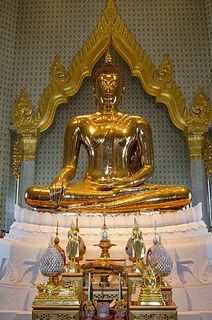
The Golden Buddha, officially titled Phra Phuttha Maha Suwana Patimakon, is a gold Maravijaya Attitude seated Buddharupa statue, with a weight of 5.5 tonnes. It is located in the temple of Wat Traimit, Bangkok, Thailand. At one point in its history the statue was covered with a layer of stucco and coloured glass to conceal its true value, and it remained in this condition for almost 200 years, ending up at what was then a pagoda of minor significance. During relocation of the statue in 1955, the plaster was chipped off and the gold revealed.

Wat Suan Dok, also known as Wat Buppharam is a Buddhist temple (Wat) in Chiang Mai, northern Thailand. It is a Royal Temple of the Third Class. The temple is on Suthep Road, approximately one kilometre west of Suan Dok gate at the west side of the moat.
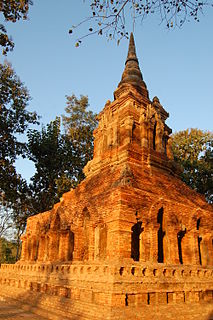
Wat Pa Sak is a wat in Chiang Saen District, Chiang Rai Province, Thailand. Located just outside the city's old walls, the temple derives its name from the 300 teaks planted on the site around the time of its foundation. Wat Pa Sak's origins date back to the 13th or 14th centuries.

Phitsanulok is an important, historic city in lower northern Thailand and is the capital of Phitsanulok Province, which stretches all the way to the Laotian border. Phitsanulok is one of the oldest cities in Thailand, founded over 600 years ago. It is best known as the birthplace of King Naresuan, who freed the country from Burmese domination in the late 16th century, and that of his brother and successor King Ekathosarot. As the crossroad between the northern and central regions of the country, it has long been important both for political and strategic reasons, and was fought over many times in centuries past. Phitsanulok was the capital of Thailand for 25 years during the reign of King Boromma Trailokanat of Ayutthaya. On the banks of the Nan River, the city was originally a small Khmer outpost known as Song Kwae, before the Khwae Noi River changed its course in the 11th century CE. Phitsanulok was also a provincial center of the Angkorian Empire during the Angkorian period. Phitsanulok is home to Naresuan University and Pibulsongkram Rajabhat University, as well as to a major Royal Thai Army base.

Wat Phra Mahathat Woramahawihan is the main Buddhist temple (wat) of Nakhon Si Thammarat Province in southern Thailand. The main stupa of the temple, Phra Borommathat Chedi, was built by King Sri Dhammasokaraja in the early-13th century CE to establish a symbol for the Theravada Buddhism sect in the province. The temple is believed to house a tooth of Gautama Buddha.




